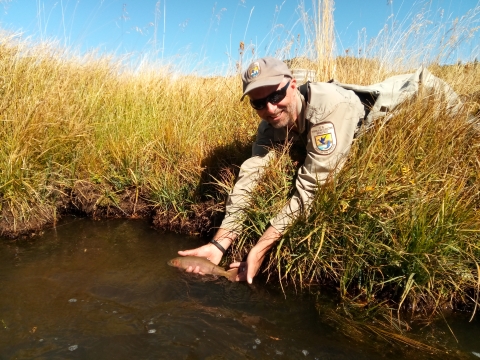Location
States
CaliforniaEcosystem
River/streamIntroduction
Paiute cutthroat trout (PCT), Oncorhynchus clarkii seleniris, are a federally listed subspecies of cutthroat trout in the Sierra Mountains of California. They were originally listed as Endangered in 1967, however were downlisted to Threatened in 1975 to enable more management actions for recovery. PCT visibly appears similar to Golden Trout, with a pale yellow to purple color, but unique physical characteristics include retaining their parr marks (dark vertical bands along their sides) as adults and lacking the distinct spotting found on other species of cutthroat trout. Juvenile PCT occupy lower flow, backwater habitats while mature PCT occupy deeper pool habitats where they can reach six to fourteen inches in length. Because they occupy high elevation streams (>8,000 ft), PCT also requires deep pool habitats for overwintering due to freezing temperatures.
PCT are endemic to a 11.1 mile stretch of Silver King Creek below Llewellyn Falls within the East Fork Carson River watershed. This range historically included three small coldwater tributaries with no competition with other native trout species. PCT were declared extinct by the early 20th century from their native stream reaches due to a combination of non-native trout introductions and habitat degradation. Past non-native rainbow trout introductions have resulted in direct competition, predation, and hybridization with native PCT.
Logging, dams for log transport, and livestock grazing in headwater streams in the 20th century further degraded habitat. Yet, local Basque sheepherders in the 20th century also inadvertently preserved the species by relocating trout to new streams above the natural barrier (Llewellyn Falls) to high alpine meadows. PCT management and recovery efforts started 74 years ago and included translocating individuals to creeks outside Silver King Creek Basin to conserve genetic lineages.
The Paiute Cutthroat Trout Restoration Project was established in 2000 as a partnership between California Department of Fish and Wildlife (CDFW), US Fish and Wildlife Service (USFWS), and U.S. Forest Service (USFS) to address recovery challenges.
Key Issues Addressed
Paiute cutthroat trout were naturally isolated to a 11.1-mile stretch of Silver King Creek. This isolated and relatively small population was particularly susceptible to both natural and anthropogenic disturbances. The PCT Restoration Project aims to recover the historic population through non-native fish removal and PCT reintroduction. Although Silver King Creek is currently located in a Wilderness-protected area with grazing banned since 1994, legacy riparian riparian
Definition of riparian habitat or riparian areas.
Learn more about riparian impacts from livestock grazing and logging are still present on the landscape. Silver King Creek also contained established non-native rainbow trout populations which outcompeted and hybridized with native PCT in their historic range. Chemical treatment was identified by project biologists to ensure complete eradication of non-native rainbow trout, but was resisted by local stakeholders in the region. Lastly, physically translocating PCT from donor populations to historic sites presents logistical challenges to ensure fish survival due to extensive travel through steep and remote backcountry terrain.
Project Goals
- Eradicate non-native rainbow trout populations from Silver King Creek through rotenone chemical treatment (piscicide)
- Evaluate effectiveness of chemical treatment on non-native fish eradication and monitor side-effects
- Reintroduce PCT from upstream source populations (e.g., Coyote Valley Creek) to their historic habitat in Silver King Creek
Project Highlights
Coming Back Home to Silver King Creek: PCT were reintroduced in September 2019 to their historic range in Silver King Creek in the Sierra Nevada following a nearly 100-year absence through ongoing recovery efforts by the California Department of Fish and Wildlife, U.S. Fish and Wildlife Service, and U.S. Forest Service. This event was celebrated by agency staff, collaborators, and local media.
- Effective Chemical Treatment: Approval for the rotenone treatment was stalled for 10 years due to legal challenges by project opponents. During this time, project partners continued to collect biological and ecological data to build a robust case for implementing the chemical treatment for non-native fish removal. In 2013, project partners finally implemented the chemical treatment after a federal judge lifted an injunction on an appeal that prevented the project from moving forward before. Rainbow trout were completely eradicated through rotenone treatment once per year from 2013-2015. Efficacy of the chemical treatment was monitored using fish in live cages and chemical monitoring of piscicide concentrations. Rotenone was detoxified at the neutralization station using potassium permanganate downstream of the treatment site, and all fish downstream of the treatment survived.
- Long-Term Streamwide Monitoring: In addition to monitoring for rainbow trout, CDFW, USFS, and USFWS collected long-term pre, during, and post treatment data across multiple years on water quality, streamflow, habitat, and other native aquatic species present including macroinvertebrates and amphibians. Pre-treatment, managers used dyes and monitored annual streamflow to determine the best time of year and chemical quantity to maximize treatment success. The chemical treatment date was scheduled to minimize impacts to non-target organisms. To date, this is one of the most comprehensive long-term datasets on rotenone impacts from before to after treatment.
- Translocation Using Horsepackers: Successful PCT translocations were conducted from an upstream site using fish cans (5 gallon aluminum containers fabricated to travel on the back of a mule wrapped in soaked burlap bags to provide cooling) strapped to pack mules through difficult backcountry conditions for two miles. CDFW and USFWS worked closely with an experienced private guide service to ensure safe fish transportation.
- Monitoring for Genetic Diversity and Habitat Connectivity: CDFW and USFWS are working with geneticists (including UC-Davis and on-staff with CDFW) to collect samples for a genetic archive that is used to evaluate the success of newly founded populations and the genetic fitness of donor populations. Ongoing stream surveys are conducted to determine suitable habitat conditions in Silver King Creek to support additional PCT introductions for recovery and monitor the population status of donor PCT populations.
Lessons Learned
Monitoring during rotenone revealed that the macroinvertebrate community was more diverse than expected. Macroinvertebrates were also quick to recover after rotenone treatments. Extensive surveys were also conducted for amphibians, including the federally Endangered Sierra Nevada yellow-legged frog and Yosemite toads, neither of which were found in treatment areas. Managers confirmed complete eradication of non-native rainbow trout through three years of surveys from 2016-2018. A mix of field methods including traditional backpack electroshocking and modern eDNA surveys were effective to monitor the presence of rainbow trout.
Maintaining quality habitat is also crucial for PCT recovery. Meadow streams provide ideal habitat to support PCT populations because the fish prefer deep pools with low velocities. Therefore, it is crucial for managers to minimize grazing impacts (U.S. Forest Service closed Silver King Creek to livestock grazing) while maintaining or increasing the abundance of seasonally inundated meadows connected to streams. Erosion control structures were also constructed in the 1980s to protect eroding stream banks and to facilitate revegetation. These were primarily log structures anchored into the stream banks with brush inserted and willow plantings behind each structure structure
Something temporarily or permanently constructed, built, or placed; and constructed of natural or manufactured parts including, but not limited to, a building, shed, cabin, porch, bridge, walkway, stair steps, sign, landing, platform, dock, rack, fence, telecommunication device, antennae, fish cleaning table, satellite dish/mount, or well head.
Learn more about structure . Although the structures have started to fail with age, they successfully reduced stream velocity and enhanced sediment deposition. The willows have also since established and will continue to enhance flow and sediment conditions to support PCT populations.
Highly endemic species like PCT are also susceptible to unpredictable environmental events. Upstream populations experienced high mortality during cold, dry winter conditions in 2013 including the formation of “anchor ice” on streams due to a lack of insulating snowpack. The effects of this to upstream PCT populations were almost as severe as a rotenone treatment. In 2017, a historical landslide caused high flows and increased sediment transport into upstream sites.
Reintroducing PCT resulted from long-term persistence and collaboration among agencies and non-profit organizations. Managers from CDFW, USFS, and USFWS made sure to include everyone who wanted to be involved in this process. This allowed partners to leverage capacity so that different organizations could pitch in to provide support and complete the various components of this project.
Next Steps
- Monitor populations to determine successful establishment in Silver King Creek. Managers will continue to evaluate habitat to determine whether any restoration projects are needed to support PCT populations. In addition, managers will continue to determine if habitat restoration is needed to build resilience to future environmental disturbances such as forest fires, flooding, and drought.
- Project biologists are working to maintain genetic diversity in PCT populations. Because PCT are highly endemic, transplanting only a few individuals can lead to founder effects (low genetic diversity resulting from few initial individuals). Managers will continue to augment the population with fish from source populations, collect genetic samples, and will work closely with geneticists to better understand how to enhance genetics of PCT populations.
- Continue to provide education to the public that highlights the benefits of native fish conservation.
Funding Partner
U.S. Fish and Wildlife Service Section 6 Funding Program
Resources
- CCAST Webinar October 2020
- CDFW Paiute Cutthroat Trout Webpage
- USFWS Species Page
- Paiute Cutthroat Trout Identification
- UC-Davis Paiute Cutthroat Trout Page
- California Department of Fish and Wildlife Document Library
- California Trout Species Accounts
- USFWS Storymap: “The Rarest Trout in North America Makes a Comeback”
Contacts
- William Somer, Senior Environmental Scientist (retired), Heritage and Wild Trout Program, California Department of Fish and Wildlife: exfishclerk@gmail.com
- Chad Mellison, Fish and Wildlife Biologist, US Fish and Wildlife Service, Reno, Nevada: chad_mellison@fws.gov
- Jim Harvey, Fisheries Biologist (retired), U.S. Forest Service, Humboldt-Toiyabe National Forest, Sparks, Nevada
- Rachel Van Horne, Biologist, U.S. Forest Service
Case Study Lead Author
Alex Koeberle, CART Research Specialist, University of Arizona, akoeberle@email.arizona.edu
Suggested Citation
Koeberle, A., L. (2020). “Native Paiute Cutthroat Trout Restoration in Silver King Creek, California.” CART. Retrieved from https://www.fws.gov/project/native-paiute-cutthroat-trout-restoration.









